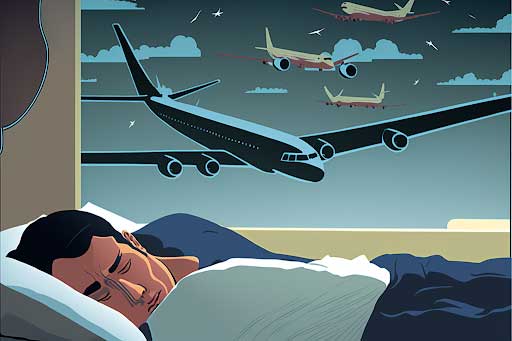 |
|
HOW TO SURVIVE A LONG HAUL FLIGHT IN 2023 |
|||
By Christopher Elliott. Illustration by Dustin Elliott |
|||
If you travel this year, you'll probably spend time on a plane. A lot of time. A recent study by MMGY Travel Intelligence suggests a full quarter of Americans who plan to take a trip in the next six months will travel internationally. That's up from 19% last year, and the highest percentage in three years. One of the top regions will be Asia-Pacific, which is ultra long-haul territory. New York to Tokyo takes 14½ hours on a plane—Los Angeles to Sydney,15 hours. Like I said, it's a lot of time. Should you take a marathon flight this year? Is an ultra long-haul flight survivable, or will you exit the aircraft looking like an extra in World War Z? To find out, I recently took three back-to-back long-haul flights and spoke with every expert I knew. I'm here to tell you that you can make it through a marathon of flights without losing your dignity and a day's sleep. But it's not easy. Nature, time zones and sitting in a pressurized aluminum tube conspire against you during your journey. I traveled the equivalent of around the world within a few days, plus or minus a few thousand miles. My jet-lag adventure took me from the southern tip of Argentina to Western Australia. Oh, the things I do for journalism. Long-haul flights make you feel like you pulled an all-nighter (or worse) The first leg didn't look that difficult: a 10½-hour overnight flight from Buenos Aires to Houston. But looks can be deceiving. I started the day standing in a long line at a small airport in southern Argentina, followed by a turbulent three-hour domestic flight and a six-hour connection. Then I was banished to the last few rows of economy class—all while recovering from a serious ski injury. And, as if that weren’t enough, it was on United Airlines, which offers practically no legroom in economy class. Of course, I didn't sleep. With only a three-hour time difference, I landed in Houston feeling like I’d pulled a college-era all-nighter, and that is not a good feeling. I slept for the next 20 hours at my uncle's home in the suburbs. The next day I returned to the airport and caught a 14½-hour flight from Houston to Doha, Qatar, and an 11-hour flight from Doha to Perth. This series of flights could have pushed me to the brink, except that the upgrade gods smiled upon me and I managed to get a seat in business class. It also helped that I was flying on Qatar Airways, where I would have been fine even in the last row of economy. Did I sleep? A few hours, sure. I still felt a little wobbly after I landed in Perth more than 30 hours later, but remarkably, I got up the next day and started working again. I'll tell you in a moment how I did it. Expert tips for handling a long-haul flight I interviewed dozens of frequent fliers to find out how they managed to get through long flights. Here's what they told me. Choose your airline carefully If you're flying long distances, don't cut corners. On a previous flight from Madrid to Buenos Aires on a discount European airline that shall remain nameless, they tried to sell us bottled water and breakfast at the end of a 13-hour flight. I'm surprised the passengers didn't mutiny. Your best bet is a seat on one of the Gulf carriers (Emirates, Etihad or Qatar Airways) or an airline specializing in long-haul flights, like Air New Zealand or Qantas. For example, Air New Zealand researched long-haul flying for five years, which led it to update its cabin with dynamic lighting to help reset your circadian rhythm. It also added a special cooling pillow for business class passengers developed by NASA. The airport in Doha, Qatar, has shopping, restaurants and an indoor green space that's in a class by itself. Ian Bradley, a spokesman for Qatar Airways, says even economy class is a premium product. "For us, it comes down to common sense—giving passengers enough legroom, in-flight entertainment and amenity kits," he says. Avoid all connections That's the advice of Scott Jordan, a frequent traveler who runs a clothing company in Sun Valley, Idaho. He had just one connection on his recent flight from Salt Lake City to Johannesburg. "I slept most of the way," he says. But on his return, he had multiple connections and delays, which left him exhausted. "The fewer connections," he adds, "the better." Don't stop drinking You know the advice to stay hydrated on a plane? Make that a double on a long-haul flight, say experts. "Hydrate, hydrate, hydrate," says Bob Bacheler, managing director of Flying Angels, a medical transport service. "And when you are done with that, hydrate more." Kylie Loyd, a travel advisor with Drift Destinations and a frequent traveler to Asia, doesn't stop drinking on a plane. "I always bring a large water bottle with me to stay hydrated," she says. "If you need more, never hesitate to ask a flight attendant. I bring my own tea bags—chamomile for when I'm trying to sleep or green tea for when I'm trying to stay awake." Oh, and never, ever drink alcohol. On a long flight, it's poison. Dress the part Wear loose clothing and bring a neck pillow, eye mask and noise-canceling headphones. I prefer in-ear headphones (I use Sony's WF-1000XM4, which also has excellent sound quality). Experienced air travelers say you should choose what you wear carefully. Take eye masks, for example. "Regular eye masks are not satisfactory," says Nick H. Kamboj, CEO of a college admissions consulting company based in Chicago. "Choose an eye mask that leaves enough room for the eye and cushions your eye socket." Don't forget the compression socks Your risk of developing deep vein thrombosis (DVT) is significantly higher on long-haul flights. Not moving for more than 10 hours can cause a deadly blood clot. Camille Yeager, a travel advisor with Travel Leaders Network, recalls it happening to one of her young clients recently. She spent the next few months on medication. "Today, I won't fly anywhere without compression socks," she says. Neither will I. Do your exercises On a related note: Stand up and move around on a long flight. Caroline Muller, who writes the travel blog Veggiewayfarer, tries to get up and walk around every hour on a long-haul flight. If she can't, she stretches her feet and calves to ensure good blood flow. "It might sound silly, but these tiny little movements really do help against the inevitable swelling of the feet," she says. When she lands she always finds a place to stretch and do a 15-minute yoga session, which helps clear her mind. What about jet lag? Transmeridian travel really wipes you out! On my ultra long-haul flight from Houston to Perth—a 14-hour time difference—I tried a new method for handling jet lag called FlyKitt, developed by a company called Fount. It uses an iPhone app, patented supplements and light-filtering glasses to adjust you to the new time zone quickly. Andrew Herr, Fount's CEO, says the technology came from his work with Navy SEALs, where he discovered that the pressure change in flight causes inflammation. "If you stop that, you can rapidly shift your circadian rhythm," he explained. I have to admit, I was a little skeptical. The app tells you when to sleep and when to take the pills, and I didn't always follow the directions exactly, especially on the last leg of my flight to Perth, when I wasn't supposed to sleep but did. Sure enough, I woke up early the next morning and had no jet lag. You can survive a long-haul flight, but … Bottom line: You can do a 10½-hour flight or back-to-back marathon flights and come out feeling semi-normal. And it's worth it for the opportunity to explore places like Argentina, Australia and Qatar. But flying long distances just for the fun of it? I'm sorry, but no. Even when the upgrade deities are on your side and invite you into business class, you still have to contend with the bone-dry air, restricted movement and jet lag. Even at their best, long flights are exhausting. Christopher Elliott is the chief advocacy officer for Elliott Advocacy, a nonprofit organization that helps consumers solve their problems. Email him at [email protected] or get help with any consumer problem by contacting him on his site. |
